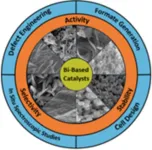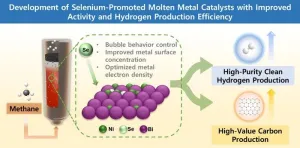The electrochemical reduction of CO2 has been recognized as a promising strategy to convert ambient atmospheric CO2 into valuable products. Bismuth-based catalysts have garnered the widespread attention of researchers due to their cost-effectiveness, low toxicity, and high natural abundance. Significant progress has been made toward enhancing the reactivity of catalyst structures through innovative synthesis techniques and engineering. Advances include the use of flow cells and membrane electrode assembly (MEA) cells to attain high cathodic current densities of over 200 mA cm-2 with superior selectivity that approaches over 90%.
Though technologies for the highly selective reduction of CO2 to formate have been realized for bismuth-based catalysts, several challenges remain that hinder their commercialization. Further advancements are essential for improving the stability of Bi-based catalysts for industrial applications. The development of in situ characterization techniques is required to be compatible with high current densities, which would provide insights into the kinetics of the CO2 reduction reaction (CO2RR) to facilitate the identification of key intermediates for real-world applications. Economic evaluations are vital for assessing the CO2RR in terms of the cost and efficacy of the CO2 reduction process. A research team has highlighted recent developments and proposed viable future directions, with their work being published in the journal Industrial Chemistry & Materials on 04 Dec 2024. The main goal of this feature article is to provide readers with the latest research progress and current challenges of CO2RR using Bi-based catalysts.
Deeper research into scalable synthesis techniques and cost-effective catalyst design is required for large-scale applications. In this feature article, a team led by Professors Aicheng Chen and Jacek Lipkowski from the University of Guelph, Canada, articulate the recent development of Bi-based catalysts for CO2RR from the viewpoints of synthesis methods and approaches that culminate in advanced performance. They also focus on in situ FTIR and Raman spectroscopic studies to decipher the mechanisms behind CO2 reduction. Further, recent progress in the electrochemical reduction of CO2 from an industrial perspective is discussed.
Bismuth nanosheets (Bi NSs) exhibit high activity and selectivity for formate formation due to their ample reactive sites for the CO2RR. Recently, the in situ (electro)chemical transformation of Bi-containing pre-catalysts has gained considerable interest for the synthesis of Bi NS catalysts. It should be noted that the attributes of initial Bi-based precursors such as morphologies, particle sizes, thicknesses, and compositions might alter the activities of Bi-based catalysts. Bi-containing metal-organic frameworks (MOFs) have also been utilized as pre-catalysts for further reconstruction to form highly active and selective Bi-based nanomaterials for the CO2RR.
Defect engineering has been employed to enhance the catalytic performance of the Bi-based catalysts. The creation of grain boundaries, edge sites, and amorphous phases, as well as the introduction of oxygen vacancies have been reported to enhance their activity and selectivity across a wide potential window. It has been revealed that defect engineering can reduce the formation energy of *OCHO intermediates, as the most energetically favored reaction pathway for the generation of formate. Moreover, electrocatalytic selectivity has been improved by Bi-based bimetallic catalysts such as CuBi, SnBi, BiIn, and ZnBi. This improvement might be ascribed to the enhanced stabilization of the key *OCHO intermediate.
Gaining insights into the in situ reconstruction of Bi-based catalysts during CO2RR is essential for a deeper elucidation of their performance. For instance, in situ Raman spectroscopic studies have shown that bismuth subcarbonate (Bi2O2CO3) forms during the CO2RR, which potentially serves as the active phase in formate production. In addition to investigating structural evolution, it is essential to detect key intermediates and clarify reaction pathways to fully grasp the reaction kinetics involved. Thus, an in situ electrochemical FTIR technique has been employed to monitor the reaction progress and identify intermediates.
“Bi-based catalysts have shown a high faradaic efficiency and selectivity for the generation of formate and may serve as a potential electrocatalyst for CO2RR to formate for industrial applications,” Chen said. Various morphologies have been attained for Bi-based catalysts showing a high faradaic efficiency for formate formation. However, several challenges still need to be addressed regarding their stability and activity for industrial applications. A few studies have demonstrated their stability for over 100 hours at current densities that exceeded 200 mA cm-2 using a gas diffusion electrode (GDE) configuration. Certain challenges such as carbonate formation during long-term electrolysis may compromise the performance of the CO2RR, as it may block the porous channels of the GDEs for CO2 diffusion. CO2 electrolysis under acidic conditions can inhibit salt precipitation; however, the engineering of the local microenvironment is required to suppress the hydrogen evolution reaction. Therefore, continued efforts should be made to enhance the stability of Bi-based catalysts for industrial applications.
Additional research is also required to develop scalable synthesis methods and cost-efficient catalysts for large-scale applications. Further investigations are needed to optimize the cell conditions and designs for the generation of concentrated formic acid, thereby reducing the costs associated with product purification and separation. Finally, the CO2RR should be evaluated from an economic and environmental standpoint. The development of a pilot-scale system for real-world testing will be essential for assessing catalyst stability, costs, and the efficiency of the CO2 reduction process.
“The main goal of this feature article is to provide readers with the latest research progress and current challenges of CO2RR using Bi-based catalysts,” Lipkowski said.
The research team includes Negar Sabouhanian (PhD candidate), Professor Jacek Lipkowski and Professor Aicheng Chen from the University of Guelph.
Industrial Chemistry & Materials is a peer-reviewed interdisciplinary academic journal published by Royal Society of Chemistry (RSC) with APCs currently waived. ICM publishes significant innovative research and major technological breakthroughs in all aspects of industrial chemistry and materials, especially the important innovation of the low-carbon chemical industry, energy, and functional materials. Check out the latest ICM news on the blog.
END








